Microsoft ends support for Internet Explorer on June 16, 2022.
We recommend using one of the browsers listed below.
- Microsoft Edge(Latest version)
- Mozilla Firefox(Latest version)
- Google Chrome(Latest version)
- Apple Safari(Latest version)
Please contact your browser provider for download and installation instructions.
September 28, 2023
World's first transmission capacity expansion and power consumption reduction using space division multiplexing technology
Optical amplifier with multi-core structure reduces power consumption by 67%
Tokyo —September 29, 2023 — NTT Corporation (NTT) have succeeded to expand transmission capacity and save energy in the C band (near the wavelength of 1550 nm), which is a major communication wavelength band. With multi-core amplification system using a core structure consisting of 12 cores arranged densely in an optical fiber for amplification, we demonstrated for the first time in the world that power consumption can be reduced by 67% compared to conventional technologies. In addition, using multi-core fiber (MCF), we found it reduces power consumption in the transmission capacity expansion. We aim to establish this technology by 2030, for one of the IOWN concept [1] to have over 10 channels of the space division multiplexing transmission line. This research will be presented on October 4, 2023, in Scotland (local time), at the 49th European Conference on Optical Communications (ECOC), the world's largest international conference on optical communication technology.
 Figure 1 Relationship Between Core Area Ratio and Conventional Power Consumption
Figure 1 Relationship Between Core Area Ratio and Conventional Power Consumption
1. Research Background
Communication infrastructure using optical fiber has become indispensable in modern time, and the demand for data will continue to increase with the introduction of 6G wireless communication, video viewing, and the spread of various services such as autonomous driving and AI generation. As a result, the transmission capacity required for optical communication platforms is expected to increase exponentially. NTT is also conducting research and development to continuously increase the transmission capacity of optical fiber communications. For example, space division multiplexing technology such as multi-core fiber [2] is expected to further expand transmission capacity in the future. However, with the current optical amplification system, as the transmission capacity expands, the power consumption of optical amplifiers, which are essential for long-distance optical communications, also increases. Therefore, in order to both expand the transmission capacity and drastically reduce the power consumption, we have studied the power saving by optical amplification using the multi-core structure in the optical amplifier [3].
2. Research Results
With the expansion of transmission line capacity by space division multiplexing technology such as multi-core fiber, the number of optical amplifiers increases with the existing amplification technology, which increases the power consumption of the entire transmission system. However, the application of optical amplification technology using a multi-core structure was expected to reduce power consumption compared to existing optical amplification technology using a single-core structure, since the excitation light [4] for amplification can be shared among multiple cores. In this study, we demonstrated for the first time in the world that power consumption can be reduced by 67% [5] compared to conventional technologies using two elemental technologies, and found the added value of reduction of power consumption in capacity expansion technology using multi-core fiber.
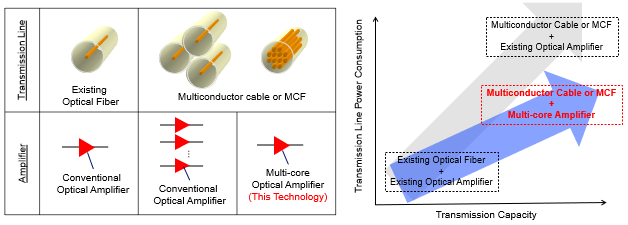 Figure 2 Configuration of Transmission Optical Fiber Line and Multiconductor Cable and Multi-core Transmission Line Optical Fiber and Optical Amplifier (left); Overview of the relationship between transmission capacity and power consumption (right)
Figure 2 Configuration of Transmission Optical Fiber Line and Multiconductor Cable and Multi-core Transmission Line Optical Fiber and Optical Amplifier (left); Overview of the relationship between transmission capacity and power consumption (right)
3. Main Point of the Technology
(1) Maximize the area ratio (core density) of cores in the cross section of the fiber for optical amplification
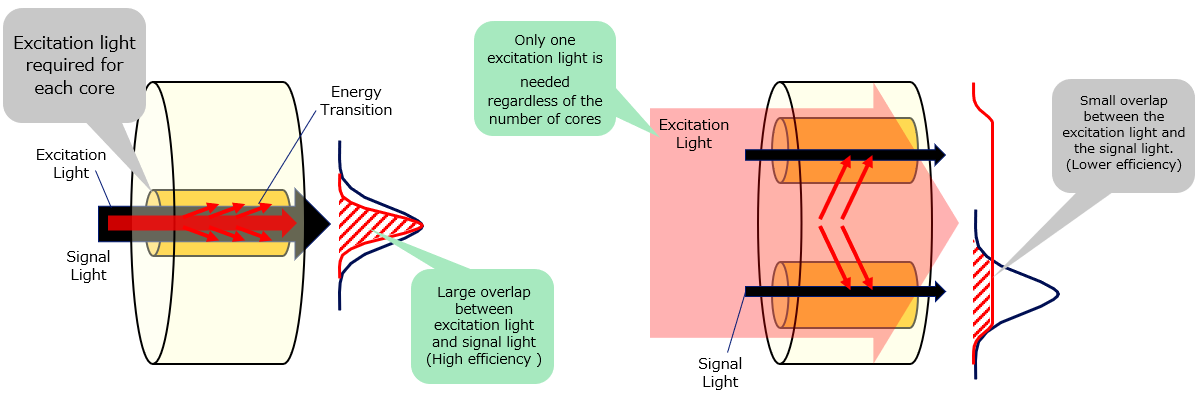 Figure 3 Overview of the Core Excitation System (left) and the Clad Excitation System (right)
Figure 3 Overview of the Core Excitation System (left) and the Clad Excitation System (right)
As shown in Figure 3, the conventional optical amplifier (core excitation method) amplifies the signal light propagating in the core by injecting excitation light in the core unit, while the optical amplifier examined in this study uses the clad excitation method, which applies excitation light to the entire cross section of the optical fiber and amplifies all the signal light propagating in multiple cores in the cross section. This system was expected to reduce power consumption by allowing multiple cores to share a single excitation laser. On the other hand, since the excitation light propagates widely across the entire optical fiber section, the overlap between the signal light and the excitation light is smaller than that of the core excitation method, and the energy transfer efficiency from the excitation light to the signal light is low (the ratio of the excitation light not used for optical amplification is large), which means that more excitation light power is required, and the expected power saving has not been achieved. As shown in Figure 4, the amplification optical fiber used in this study maximized the area ratio of the core to the cladding by reducing and enlarging the outer diameter (cladding diameter) and core diameter of the fiber for optical amplification, while maintaining the same multi-core arrangement (number of cores and core spacing) as the optical fiber transmission line, thereby maximizing the efficiency of use of excitation light.
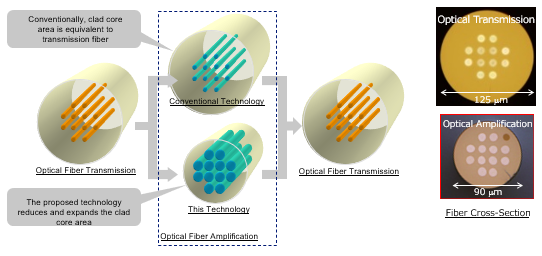 Figure 4 Design Overview for Maximizing Core Area Ratio (Core Density)
Figure 4 Design Overview for Maximizing Core Area Ratio (Core Density)
(2) Optimization of optical amplifier configuration minimizes loss of excitation light.
Since the cladding diameter is reduced to increase the area ratio of the core of the amplifying optical fiber, the cladding diameter does not match at the connection point between the transmission line optical fiber and the amplifying optical fiber, and a part of the exciting light is lost. In addition, both conventional and proposed technologies generate excitation light that is not used for optical amplification but remains after propagation of the optical fiber for amplification and is removed. In this study, as shown in Figure 5, by adopting a tapered structure and a reflective device, we succeeded in reducing excitation light loss and residual excitation light, and further increasing the efficiency of light amplification.
- Taper structure …Minimizes coupling loss of newly generated excitation light by reduction of cladding diameter of optical fiber for amplification
- Reflection Devices…Minimize the percentage of residual excitation light by reusing excitation light not used for light amplification
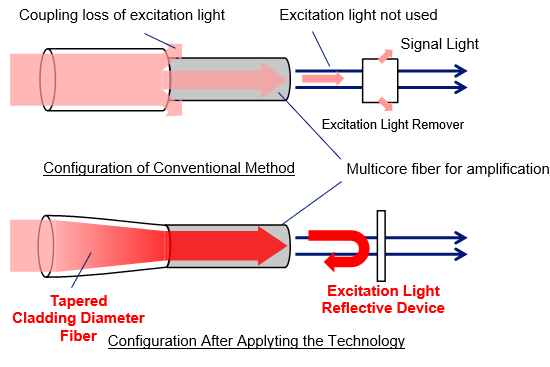 Figure 5 Images of Excitation Light Coupling Loss and Minimization of Residual Excitation Light
Figure 5 Images of Excitation Light Coupling Loss and Minimization of Residual Excitation Light
4. Outlook
With the aim of increasing transmission capacity and considering global environment, we have demonstrated a drastic reduction in the power consumption of optical amplifiers, by achieving both a higher transmission line capacity and a lower power consumption. In the future, we will construct a relay transmission line that combines transmission line optical fiber and this optical amplifier to demonstrate power-saving, long-distance, and large-capacity optical amplification transmission, and aim to establish the technology by 2030 as a part IOWN to have over 10 channels of the space division multiplexing transmission line.
We will also contribute to the promotion of NTT Green Innovation toward 2040 [6].
< Reference and Glossary >
[1]IOWN concept
The IOWN (Innovative Optical and Wireless Network) is an initiative for networks and information processing infrastructure including terminals that can provide high-speed, high-capacity communication utilizing innovative technology focused on optics, as well as tremendous computational resources. This is done in order to overcome the limitations of existing infrastructure with innovative technologies, optimize the individual with the whole based on all available information, and create a rich society that is tolerant of diversity.
https://www.rd.ntt/e/iown/
[2]Space Division Multiplexing Technology
A technology for extending the propagation of light from one optical fiber to multiple optical fibers. For example, there is a multi-core fiber with multiple cores in the cross section of a single fiber that is the path of light.
https://group.ntt/en/newsrelease/2017/08/08/170808b.html
[3]Optical Amplifier
Light propagating through an optical fiber is attenuated by distance. An optical amplifier is a device that amplifies, and relays attenuated light to the next optical fiber in order to enable optical fiber communication over hundreds to thousands of kilometers. In general, signal light is amplified by injecting excitation light into an amplification optical fiber (erbium-doped optical fiber) to which the element erbium is added.
https://group.ntt/en/newsrelease/2017/08/08/170808b.html
[4]Excitation Light
Light that enters the optical fiber for amplifying signal light. Generally, 980 nm light is used, which is different from the wavelength of the signal light (around 1550 nm).
[5]Overview of Power Consumption Compared to Conventional Technology
The power consumption of the excitation laser WLD is determined from the excitation optical power required to obtain the desired amplification amount. For cladding excitation of the N core, WLD / N (N = 1 for core excitation) was defined as the power consumption of the optical amplifier.
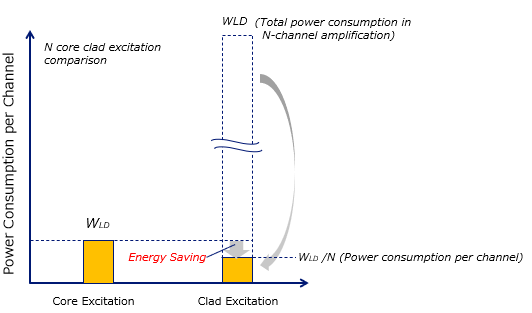 Reference Figure Overview of Power Consumption Comparison of Core or Cladding Excitation Amplifiers
Reference Figure Overview of Power Consumption Comparison of Core or Cladding Excitation Amplifiers
[6]NTT Green Innovation toward 2040
The new Environmental Energy Vision aims to simultaneously realize the objectives of "zero environmental impact" and "economic growth" by "reducing environmental impact through business activities" and "creating innovations that break limits."
https://group.ntt/en/newsrelease/2021/09/28/210928a.html
About NTT
NTT contributes to a sustainable society through the power of innovation. We are a leading global technology company providing services to consumers and business as a mobile operator, infrastructure, networks, applications, and consulting provider. Our offerings include digital business consulting, managed application services, workplace and cloud solutions, data center and edge computing, all supported by our deep global industry expertise. We are over $95B in revenue and 330,000 employees, with $3.6B in annual R&D investments. Our operations span across 80+ countries and regions, allowing us to serve clients in over 190 of them. We serve over 75% of Fortune Global 100 companies, thousands of other enterprise and government clients and millions of consumers.
Media contact
NTT
Information Network Laboratory Group, Public Relations
nttrd-pr@ml.ntt.com
Information is current as of the date of issue of the individual press release.
Please be advised that information may be outdated after that point.
NTT STORY
WEB media that thinks about the future with NTT










